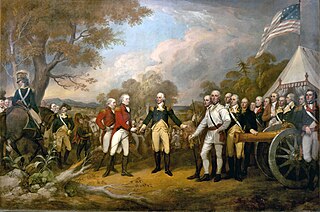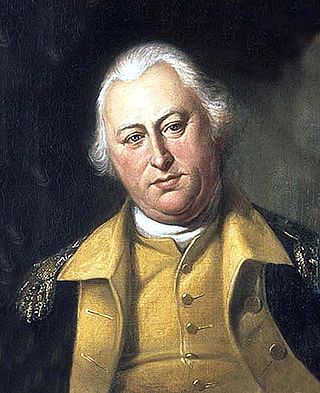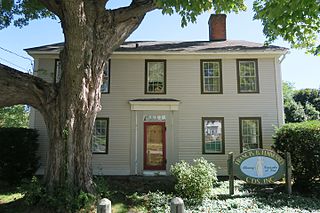Related Research Articles

The Battles of Saratoga marked the climax of the Saratoga campaign, giving a decisive victory to the Americans, significantly supported by the French, over the British in the American Revolutionary War. British General John Burgoyne led an invasion army of 7,200–8,000 men southward from Canada in the Champlain Valley, hoping to meet a similar British force marching northward from New York City and another British force marching eastward from Lake Ontario; the goal was to take Albany, New York. The southern and western forces never arrived, and Burgoyne was surrounded by American forces in upstate New York 15 miles (24 km) short of his goal. He fought two battles which took place 18 days apart on the same ground 9 miles (14 km) south of Saratoga, New York. He gained a victory in the first battle despite being outnumbered, but lost the second battle after the Americans returned with an even larger force.

The Saratoga campaign in 1777 was an attempt by the British high command for North America to gain military control of the strategically important Hudson River valley during the American Revolutionary War. It ended in the surrender of the British army, which historian Edmund Morgan argues, "was a great turning point of the war, because it won for Americans the foreign assistance which was the last element needed for victory."

Enoch Poor was a brigadier general in the Continental Army during the American Revolutionary War. He was a ship builder and merchant from Exeter, New Hampshire.

Benjamin Lincoln was an American army officer. He served as a major general in the Continental Army during the American Revolutionary War. Lincoln was involved in three major surrenders during the war: his participation in the Battles of Saratoga contributed to John Burgoyne's surrender of a British army, he oversaw the largest American surrender of the war at the 1780 siege of Charleston, and, as George Washington's second in command, he formally accepted the British surrender at Yorktown.

William Heath was an American farmer, soldier, and political leader from Massachusetts who served as a major general in the Continental Army during the American Revolutionary War.
The 3rd New Hampshire Regiment, also known as the 2nd Continental Regiment, was authorized on 22 May 1775, organized 1–8 June 1775, and adopted into the Continental Army on 14 June 1775, as the third of three regiments raised by the state of New Hampshire during the American Revolution. The enlistment dates for officers and rank and file soldiers extended to 23 April 1775, based on their response to the alarm for the Battles of Lexington and Concord.

The 2nd New Hampshire Regiment was formed in early May 1775, as the second of three Continental Army regiments raised by the state of New Hampshire during the American Revolutionary War. Its first commander was Colonel Enoch Poor, with Joseph Cilley as major. Many of the men who served in the unit hailed from southeastern New Hampshire and western Maine. During the first part of its service, the regiment took part in the siege of Boston, and there is a link below in the reference section to the orderly book of an officer in the unit during that time.
The New Hampshire Militia was first organized in 1631 and lasted until 1641, when the area came under the jurisdiction of Massachusetts. After New Hampshire became an separate colony again in 1679, New Hampshire Colonial Governor John Cutt reorganized the militia on March 16, 1680, with one foot company apiece for the four major settlements in Portsmouth, Dover, Exeter and Hampton, and an artillery and cavalry company in Portsmouth. The King of England authorized the Provincial Governor to give commissions to persons who shall be best qualified for regulating and discipline of the militia. President Cutt placed Major Richard Waldron of Dover in command of the Militia. In 1879, the Militia was designated by the state as the New Hampshire National Guard.
Nichols' Regiment of Militia also known as the 5th New Hampshire Militia Regiment was called up on July 21, 1777 at Winchester, New Hampshire, for Gen. John Stark's Brigade gathering at Charlestown, New Hampshire during the Saratoga Campaign. It was named for Dr Moses Nichols, who was appointed colonel of the regiment in 1776.
Simonds' Regiment of Militia also known as the 2nd Berkshire County Regiment was raised in Berkshire County, Massachusetts during the American Revolutionary War. The Regiment was at Fort Ticonderoga during the winter of 1776–1777. Simonds' Regiment was called up in the summer of 1777 during the Saratoga Campaign fighting at the Battle of Bennington with General John Stark's Brigade of New Hampshire Militia. Many volunteers also joined the regiment at this time including William Easton, and the "Fighting Parson," Thomas Allen. Simonds' Regiment attacked Friedrich Baum's redoubt from the south during the battle as Stickney's, Hale's and Hobart's attacked form the east and Nichols' attacked from the west. The regiment would continue on to the Battle of Bemis Heights and the surrender of British General John Burgoyne's army. The regiment would also be called up in response to Carleton's Raid and the Royalton Raid of 1780.

Woodbridge's Regiment of Militia, also known as the "1st Hampshire County Militia Regiment" and "Woodbridge's (25th) Regiment" and "The 25th Regiment of Foot". On April 20, 1775, the day immediately following the Battles of Lexington and Concord, Woodbridge's regiment was formed and marched to Cambridge, Massachusetts near Boston, and participated in the siege of Boston and the Battle of Bunker Hill.
Jonathan Chase was a soldier in the American Revolutionary War.
The Van Alstyne's Regiment of Militia, also known as the 7th Albany County Militia Regiment, was called up in July, 1777 at Kinderhook, New York to reinforce Gen. Horatio Gates's Continental Army during the Saratoga Campaign. The regiment served in Brigadier General Abraham Ten Broeck's Brigade. With the defeat of General John Burgoyne's British Army on October 17, 1777, the regiment stood down. It is uncertain whether the regiment participated in the October 7 Battle of Bemis Heights, and if it did, whether the entire regiment was there.
Nathan Hale was an American Revolutionary War officer who fought in the Battle of Lexington and Concord, Battle of Bunker Hill, and the Siege of Fort Ticonderoga, Hale was caught at British borders in Manhattan, New York and was hanged at the age of 21.

Alexander Scammell was a Harvard educated attorney and an officer in the Continental Army during the American Revolutionary War. He was wounded on September 30, 1781, near Yorktown and subsequently died on October 6 in Williamsburg, Virginia, making him, a colonel, the highest ranking American officer killed during the Siege of Yorktown.

Benjamin Ruggles Woodbridge was an American physician, lawyer, farmer, and military officer who served as a colonel in the Massachusetts militia during the American Revolutionary War. Woodbridge was a commander at the Battle of Bunker Hill, and also owned a rum still, a wood lot, a grazing meadow, and a mill, and came to be the wealthiest man in South Hadley, Massachusetts. Colonel Woodbridge was also a member of the Massachusetts legislature for many years.

The John Spurr House is an historic house on Main Street in Charlton, Massachusetts. The house was built in 1798 and added to the National Historic Register in 1976.
Events from the year 1777 in the United States.
References
- ↑ "Document". NYPL Digital Collections. Retrieved 2020-01-18.
- ↑ Massachusetts. Office of the Secretary of State (1896–1908). Massachusetts soldiers and sailors of the revolutionary war. A compilation from the archives. University of California Libraries. Boston, Wright and Potter Printing Co., State Printers.
- "Document". NYPL Digital Collections. Retrieved 2020-01-18.
- Massachusetts. Office of the Secretary of State (1896–1908). Massachusetts soldiers and sailors of the revolutionary war. A compilation from the archives. University of California Libraries. Boston, Wright and Potter Printing Co., State Printers.